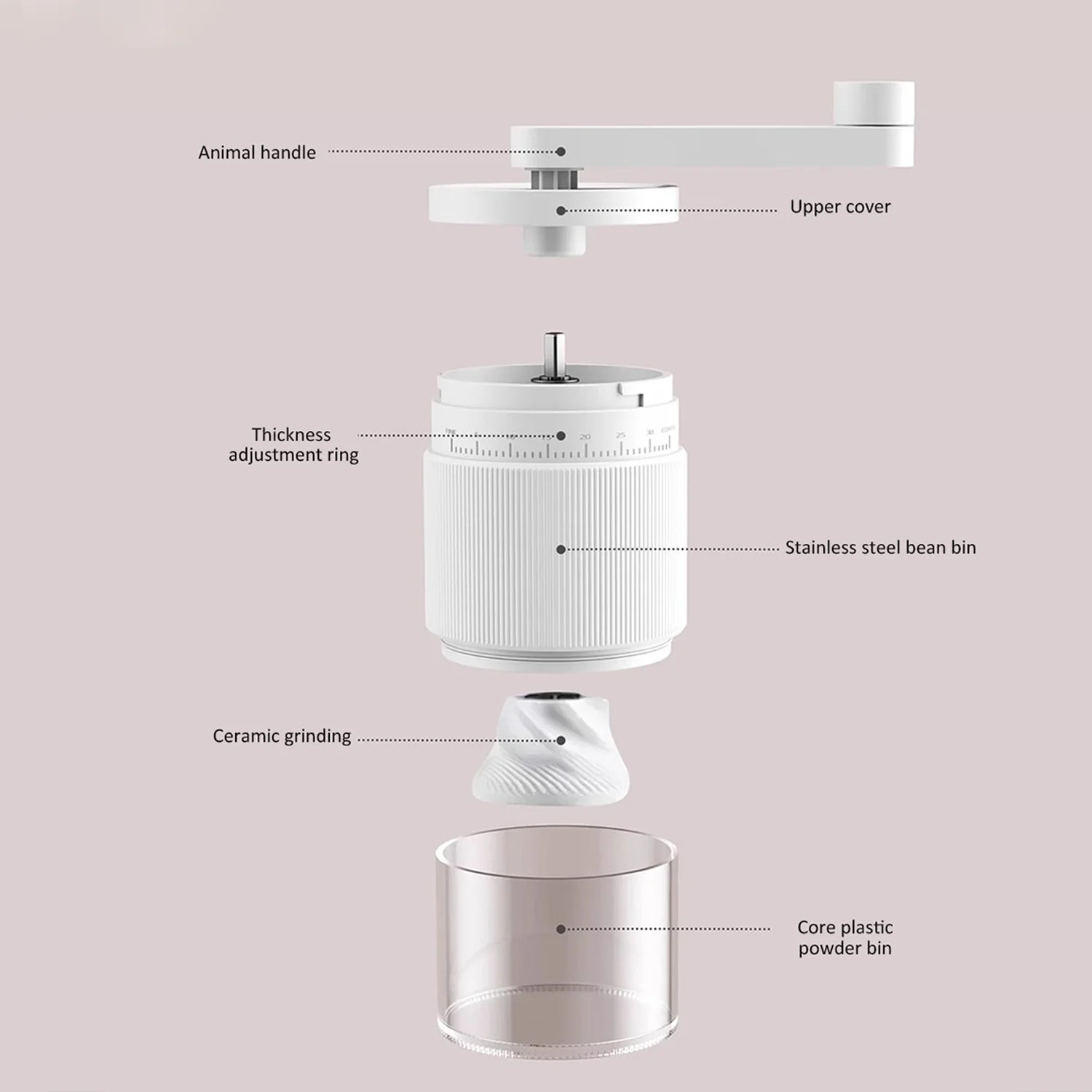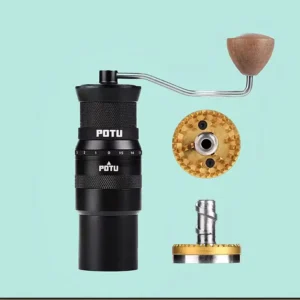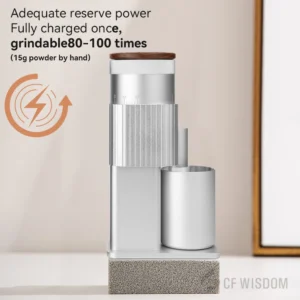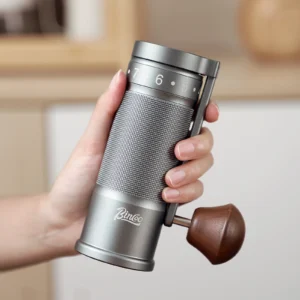Introduction: The Foundation of Your Coffee Experience
The journey to a perfect cup of coffee begins long before water touches grounds. At the heart of exceptional brewing lies one critical element that many overlook: the quality of your grind. Even the finest beans from the most prestigious origins can yield disappointing results when improperly ground.
Burr grinders have established themselves as the gold standard for coffee enthusiasts seeking consistency and precision. Unlike their blade counterparts that chop beans haphazardly, burr grinders crush coffee beans between two abrasive surfaces with remarkable uniformity. This consistency is non-negotiable – uneven grounds extract at different rates, resulting in coffee that’s simultaneously bitter (from over-extracted fine particles) and sour (from under-extracted coarse pieces).
But within the world of burr grinders lies an important decision: ceramic or steel burrs? This seemingly simple choice affects everything from flavor profile to longevity, maintenance requirements to price point. The material grinding your precious beans impacts your daily brewing ritual in ways you might not have considered.
For coffee lovers seeking to elevate their brewing game, understanding the distinct characteristics of comparing burr blade grinders is the first step toward finding the perfect match for your unique preferences and brewing style. This comprehensive guide will illuminate the differences that matter, drawing on extensive testing and coffee science to help you make an informed decision.
Understanding How Burr Grinders Work
Before diving into the ceramic versus steel debate, let’s explore the fundamental mechanics that make burr grinders superior coffee preparation tools.
Burr grinders operate using two abrasive surfaces – the burrs – positioned a precise distance apart. As coffee beans pass between these surfaces, they’re methodically crushed to a consistent size determined by the gap setting. Unlike blade grinders that randomly chop beans, creating fragments of widely varying sizes, burr grinders produce uniform particles that extract at similar rates during brewing.
This grinding mechanism consists of two main components: a stationary burr and a rotating burr. Coffee beans enter through a hopper at the top, funneling into the grinding chamber where the burrs crush them with remarkable precision. The ground coffee then exits through the bottom, ready for brewing.
It’s crucial to distinguish between the burr material (ceramic vs. steel) and burr shape (conical vs. flat). While this guide focuses primarily on the material comparison, the shape contributes significantly to grinding characteristics. Conical burrs feature a cone-shaped center burr that rotates within an outer serrated burr, while flat burrs use two parallel rings with cutting teeth.
The choice between ceramic vs steel burr comparison influences several key aspects of your grinding experience:
- Grind quality and consistency
- Heat generation during grinding
- Long-term durability and maintenance requirements
- The tactile feel of grinding (particularly in manual grinders)
- Potential flavor impacts in your brewed coffee
Understanding these fundamental mechanics helps contextualize why different manual coffee burr grinders perform differently despite similar appearances. The material grinding your beans isn’t merely a technical specification – it’s a critical variable that shapes your entire brewing experience.
Ceramic Burrs: Comprehensive Analysis
Ceramic burr grinders have earned dedicated followers among coffee enthusiasts for specific performance characteristics that set them apart from their steel counterparts. These burrs are typically constructed from zirconium oxide, an exceptionally hard ceramic material that undergoes high-temperature firing to achieve remarkable hardness and wear resistance.
Advantages of Ceramic Burrs
Superior Hardness and Wear Resistance: Ceramic burrs score significantly higher on the Mohs hardness scale than steel varieties. This exceptional hardness translates to remarkable edge retention, maintaining consistent grinding performance over extended periods. Many ceramic burrs can process hundreds of pounds of coffee before showing measurable wear patterns.
Minimal Heat Transfer: Ceramic has naturally lower thermal conductivity than steel, meaning less heat transfers to your coffee during grinding. This thermal stability helps preserve delicate volatile compounds responsible for aroma and flavor nuance, particularly beneficial for light roasts with subtle flavor profiles.
Corrosion Resistance: Unlike some steel variants, ceramic burrs never rust or oxidize. This complete corrosion resistance simplifies maintenance and ensures consistent performance in humid environments.
Longevity: With proper care and assuming no accidental damage, quality ceramic burrs often outlast their steel equivalents by a significant margin, making them cost-effective over the long term despite higher initial investment.
Disadvantages of Ceramic Burrs
Brittleness and Chip Risk: The primary vulnerability of ceramic burrs is their susceptibility to chipping or cracking when encountering foreign objects (like small stones) that occasionally contaminate coffee beans. This brittleness requires more cautious bean sorting and handling.
Higher Manufacturing Costs: The production process for precision ceramic burrs typically involves more expensive materials and manufacturing techniques, which explains their higher price point in comparable grinder models.
Quality Variations: The performance of ceramic burrs can vary significantly between manufacturers, with some lower-quality options exhibiting inconsistent grinding surfaces that impact performance.
Ideal Use Cases for Ceramic Burrs
Ceramic burrs excel in several specific scenarios. They’re particularly well-suited for espresso grinding, where their heat-resistant properties and exceptional consistency at fine settings yield superior results. Home brewers who prioritize flavor preservation in light to medium roasts often prefer ceramic burrs for their thermal stability. Additionally, the ceramic burr longevity guide reveals why they’re often preferred by those seeking low maintenance and long-term value.
For those exploring options, our ceramic burr coffee grinder collection showcases the range of quality and design available in this category.
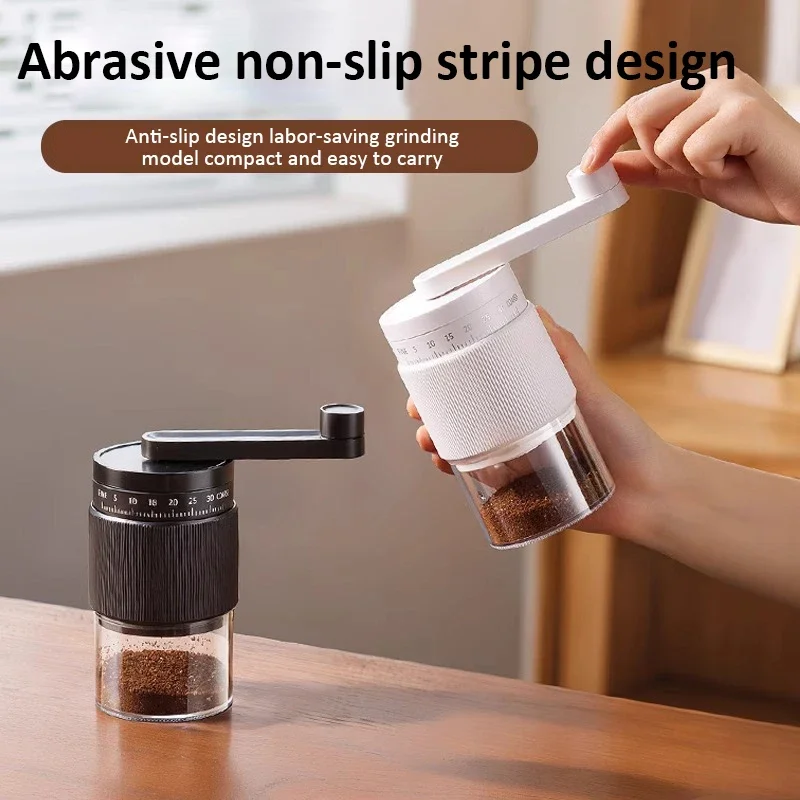
Steel Burrs: Comprehensive Analysis
Steel burrs represent the traditional choice for coffee grinding and remain the predominant option in commercial settings. Typically crafted from hardened stainless steel or specialized tool steel alloys, these burrs offer a distinct set of characteristics that appeal to many coffee enthusiasts and professionals alike.
Advantages of Steel Burrs
Superior Initial Sharpness: Steel burrs generally begin their life with exceptionally sharp cutting edges. This sharpness translates to efficient grinding, requiring less force in manual grinders and creating less friction during the grinding process.
Impact Resistance: Unlike ceramic, steel burrs can withstand occasional encounters with foreign objects without chipping or cracking. This resilience makes them forgiving of the occasional stone or twig that might find its way into your coffee beans.
Versatile Performance: Steel burrs typically excel across the entire spectrum of grind sizes, from ultra-fine espresso to coarse French press settings. This versatility makes them excellent all-purpose performers for brewers who frequently switch between methods.
Accessibility: Steel burr grinders are available across various price points, making quality grinding accessible to more coffee enthusiasts. The manufacturing process for steel burrs is more standardized, resulting in more consistent quality even in mid-range options.
Disadvantages of Steel Burrs
Heat Conductivity: Steel’s higher thermal conductivity means these burrs can transfer more heat to coffee during grinding, potentially affecting volatile compounds. Understanding heat retention steel vs ceramic differences helps brewers adapt their technique to minimize this effect.
Gradual Dulling: Over time and with regular use, steel burrs gradually lose their edge sharpness. While this process is slow, long-term users may notice subtle changes in grind consistency after processing many pounds of coffee.
Potential Rust Concerns: Non-stainless steel burrs can develop rust if exposed to moisture. While most quality burrs use corrosion-resistant alloys, proper drying and maintenance remain important.
Ideal Use Cases for Steel Burrs
Steel burrs demonstrate particular strengths in several contexts. Their durability makes them ideal for travel and portable grinders that might encounter rough handling. Our stainless steel manual coffee grinders collection showcases options optimized for portability and resilience.
For daily home use with varied brewing methods, steel burrs provide versatile performance across grind sizes. Their ability to handle higher volumes without overheating also makes them preferred for steel burrs commercial coffee operations where throughput and consistency are paramount.
Direct Comparison: Ceramic vs Steel Performance
When comparing ceramic and steel burrs directly, several key performance factors emerge that influence the grinding experience and results. The following comprehensive comparison addresses the most important considerations for coffee enthusiasts making this critical decision.
Grind Consistency Comparison
| Factor | Ceramic Burrs | Steel Burrs |
|---|---|---|
| Fine Grind Consistency | Excellent | Very Good |
| Coarse Grind Consistency | Good | Excellent |
| Particle Size Distribution | Very uniform at fine settings | Very uniform at medium/coarse |
| Fines Production | Minimal | Slightly higher |
| Long-term Consistency | Maintains longer | Gradually changes |
Durability & Practical Considerations
| Factor | Ceramic Burrs | Steel Burrs |
|---|---|---|
| Resistance to Foreign Objects | Poor (chips easily) | Excellent |
| Expected Lifespan | 1500-2000 lbs of coffee | 500-1000 lbs of coffee |
| Heat Generation | Minimal | Moderate |
| Noise Level | Generally quieter | Slightly louder |
| Static Generation | Low to moderate | Moderate to high |
| Initial Cost | Higher | Lower |
| Long-term Value | Excellent if not damaged | Good with proper care |
Beyond the table comparisons, it’s important to understand nuances that affect real-world performance. For instance, while ceramic burrs generally maintain their edge longer, this advantage diminishes if they chip from encountering a stone. Similarly, while steel burrs may generate more heat theoretically, grinder design and grinding speed have greater practical impact than burr material alone.
The durability differences between ceramic and steel burrs reveal that manufacturing quality often matters more than material alone. Premium steel burrs from respected manufacturers frequently outperform budget ceramic options, highlighting that material is just one aspect of overall grinder quality.
When evaluating options, considering which materials make the best burrs for your specific brewing needs helps narrow the field to suitable candidates. Remember that implementation and engineering quality often outweigh the material distinction in determining overall performance.
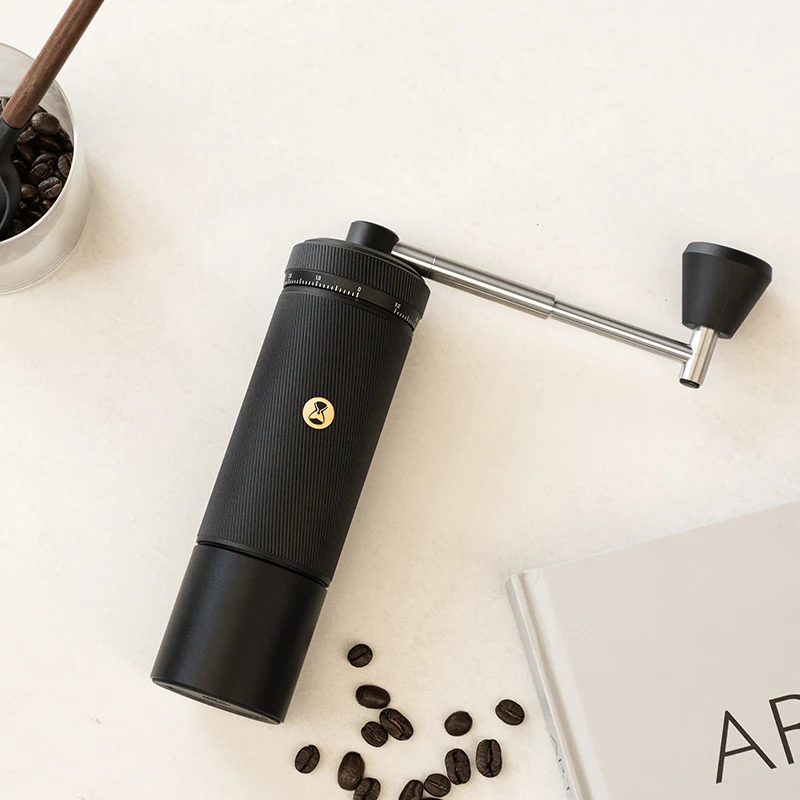
Flavor Impact: How Burr Material Affects Your Cup
Perhaps the most contentious aspect of the ceramic versus steel debate centers on flavor impact. Does burr material genuinely affect the taste of your coffee? The evidence suggests subtle but discernible differences that certain brewers, particularly those working with specialty coffee, may appreciate.
Heat Transfer and Flavor Preservation
The primary mechanism through which burr material influences flavor is heat management during grinding. Coffee contains hundreds of volatile aromatic compounds that contribute to its complex flavor profile. These compounds are sensitive to heat, which can cause premature evaporation or chemical changes before brewing begins.
Ceramic’s lower thermal conductivity minimizes heat transfer to coffee particles during grinding. This thermal stability helps preserve delicate flavor compounds, particularly in light-roasted coffees where floral, fruit, and acid notes predominate. Conversely, steel’s higher thermal conductivity can potentially generate more heat during extended grinding sessions, though this effect is minimal in well-designed grinders used appropriately.
Extraction Differences
The impact of coffee flavor ceramic steel burrs extends beyond heat to include particle distribution characteristics. Ceramic burrs typically produce slightly more uniform particles with fewer fines (ultra-small particles) at espresso settings. This uniformity translates to more even extraction, often yielding:
- Enhanced clarity and definition between flavor notes
- Brighter, more pronounced acidity
- Cleaner mouthfeel with less sediment
Steel burrs, while still highly consistent, sometimes produce a slightly different particle distribution pattern that can result in:
- Slightly fuller body
- Enhanced perception of sweetness
- More pronounced deep notes like chocolate and caramel
Coffee Type Considerations
Different coffee origins and roast levels may perform better with specific burr materials:
- Single-origin light roasts often benefit from ceramic burrs’ heat management and clarity
- Dark roasts may pair well with either material, with some preferring steel’s ability to emphasize body
- Espresso blends can excel with either material, though ceramic often produces more balanced shots
For those focused on espresso preparation, exploring our espresso coffee hand grinders collection reveals options optimized for the precision required for consistent shots.
Matching Burr Material to Brewing Method
Different brewing methods extract coffee under varying conditions – pressure, time, temperature, and grind size all play crucial roles. The ideal burr material often depends on the specific demands of your preferred brewing technique.
Espresso: Precision Under Pressure
Espresso extraction demands exceptional precision, applying 9 bars of pressure to coffee ground to powder-like consistency. The ultimate guide burr materials espresso reveals why many enthusiasts prefer ceramic burrs for this application:
- Superior fine grind consistency creates even resistance to pressurized water
- Lower heat generation preserves volatile compounds during the intensive grinding required
- Excellent particle uniformity reduces channeling issues during extraction
However, premium steel burrs specifically designed for espresso can perform exceptionally well, especially in commercial settings where grinding volume is high.
Pour-Over and Filter Methods
For pour-over methods like V60, Chemex, or drip machines, medium-fine grinds extract over 2-4 minutes. Both burr materials perform admirably here, with considerations including:
- Ceramic offers excellent clarity and bright acidity, enhancing floral notes
- Steel provides consistent performance across different roast levels
- Grind size consistency matters more than material at these medium settings
French Press and Cold Brew
Coarse grinding for immersion methods reveals steel’s advantage in producing consistent large particles with minimal fines:
- Steel burrs typically create more uniform coarse grinds
- Less risk of damage when rapidly adjusting from fine to coarse settings
- Superior particle distribution for clean French press brewing
Finding Your Perfect Match
Ultimately, mastering espresso precision grind settings and understanding how different brewing methods extract coffee helps determine which burr material aligns with your coffee journey. Consider which flavor characteristics you prioritize and which brewing methods dominate your routine when making this important decision.
Fine Adjustment Hand Grinder, Precision Manual Grinder, Travel Coffee Grinder
Price range: $185.11 through $494.63 Select options This product has multiple variants. The options may be chosen on the product pageHand Burr Grinder, Hand Crank Coffee Grinder, Manual Espresso Grinder, Portable Coffee Grinder
Price range: $262.72 through $300.22 Select options This product has multiple variants. The options may be chosen on the product pageManual Burr Mill, Manual Coffee Grinder Stainless Steel, Manual Coffee Mill Grinder, Mechanical Coffee Grinder
Price range: $127.26 through $130.32 Select options This product has multiple variants. The options may be chosen on the product pageHand Burr Grinder, Manual Coffee Grinder Stainless Steel, Precision Manual Grinder
Price range: $183.64 through $187.52 Select options This product has multiple variants. The options may be chosen on the product page
At Savor Suite, we’ve tested both materials extensively across brewing methods to curate a collection that offers optimal performance for each application.
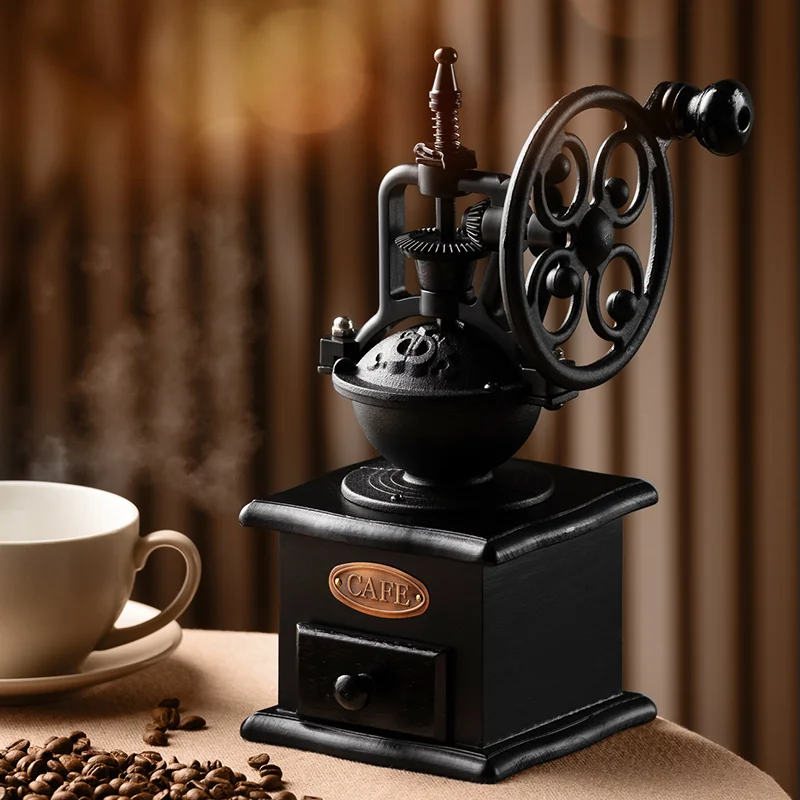
Manual vs Electric Grinders: Material Considerations
The ceramic versus steel comparison takes on additional dimensions when considering manual versus electric grinders. The physical properties of each material interact differently with these distinct mechanisms, creating unique advantages in each format.
Material Impact in Manual Grinders
In hand grinders, the user directly experiences the resistance and feedback from the burrs. This tactile connection reveals important differences:
Grinding Effort: Ceramic burrs typically require more physical force to turn, particularly at finer settings. This resistance comes from ceramic’s higher friction coefficient against coffee beans. For daily manual grinding, this additional effort can be a meaningful consideration.
Stability and Alignment: The properties of hand burr grinder mechanisms interact differently with burr materials. Ceramic’s slight brittleness requires more precise shaft and bearing design to maintain perfect alignment during grinding. Steel’s resilience can sometimes better accommodate minor alignment imperfections without affecting performance.
Heat Management: Manual grinding occurs at much slower speeds than electric grinding, minimizing heat generation regardless of material. However, heat transfer manual coffee grinders studies show ceramic still maintains a slight advantage in prolonged grinding sessions.
Material Considerations in Electric Grinders
Electric grinders introduce different variables that interact with burr material properties:
Motor Heat Contribution: Electric motors generate heat independently of the burrs. This additional heat source can compound with steel’s thermal conductivity, making ceramic potentially advantageous for heat-sensitive applications.
Grinding Speed: Electric grinders operate at much higher RPMs than manual grinding. At these higher speeds, steel’s superior impact resistance provides greater protection against potential damage from foreign objects.
Commercial Applications: Commercial environments prioritize throughput and durability under heavy use. Steel’s resilience makes it the overwhelming choice for high-volume café settings where grinders might process hundreds of doses daily.
When selecting between manual and electric options, consider how your typical use patterns align with these material characteristics. For travel and portable applications, steel’s durability often provides peace of mind, while ceramic’s heat management can benefit dedicated espresso enthusiasts using electric home grinders.
Maintenance and Longevity: Caring for Different Burrs
Proper maintenance significantly extends the life of both ceramic and steel burrs while ensuring consistent performance. Each material requires specific care approaches to address its unique properties and vulnerabilities.
Ceramic Burr Maintenance
Ceramic burrs require particular attention to prevent damage while keeping them clean:
Regular Cleaning: Every 1-2 weeks (or 1-2 pounds of coffee), disassemble the grinder and gently brush away coffee oils and particles from ceramic surfaces. Avoid tapping or knocking ceramic burrs against hard surfaces.
Safe Cleaning Methods:
– Use a soft brush specifically designated for grinder cleaning
– Apply compressed air to remove stubborn particles
– NEVER use water or liquid cleaners on ceramic burrs
– Consider specialized grinder cleaning products designed to absorb oils without causing damageDamage Prevention: Before grinding, quickly inspect beans for any foreign objects like small stones that could chip ceramic edges. Store your grinder in a stable location where it won’t be knocked or dropped.
Warning Signs: Watch for sudden changes in grinding sound, resistance, or consistency, which may indicate a chipped burr requiring replacement.
Steel Burr Maintenance
Steel burrs benefit from regular maintenance to prevent oil buildup and maintain peak performance:
Regular Cleaning: Follow the same 1-2 week schedule as ceramic burrs, with additional attention to removing coffee oils that tend to adhere more readily to steel surfaces.
Effective Cleaning Methods:
– Use specialized grinder cleaning products to absorb oils
– For non-stainless variants, ensure burrs are completely dry after cleaning
– Consider running a small amount of rice through the grinder occasionally to absorb oils (check manufacturer recommendations first)Rust Prevention: For non-stainless steel burrs, minimize exposure to moisture and ensure complete drying after cleaning. Store in a low-humidity environment when possible.
Performance Monitoring: Note any gradual increase in grinding time or decreased consistency, which may indicate dulling requiring burr replacement.
Our guides on cleaning manual burr grinders and maintaining manual coffee grinders provide detailed step-by-step procedures for preserving optimal performance regardless of your burr material.
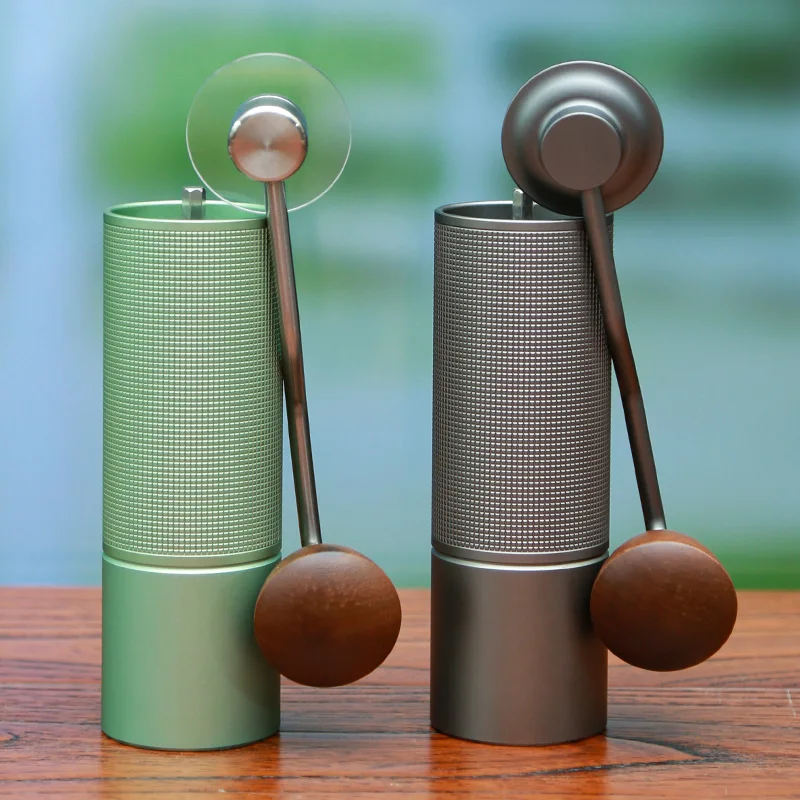
Decision Framework: Choosing Your Ideal Burr Material
With comprehensive understanding of both materials, the following framework helps identify which burr type best aligns with your specific needs and preferences:
Primary Brewing Method
- Primarily Espresso: Ceramic burrs often excel at the ultra-fine consistency required for balanced extraction under pressure. Their thermal properties help preserve delicate volatile compounds.
- Mainly Pour-Over/Drip: Either material performs admirably at medium grind settings. Consider other factors below.
- Primarily French Press/Cold Brew: Steel burrs typically produce more consistent coarse grounds with fewer fines.
- Multiple Brewing Methods: Steel offers versatile performance across the grind spectrum, making it adaptable for those who regularly switch between methods.
Usage Pattern
- Daily Heavy Use: Steel’s durability withstands regular usage and adjustment, though premium ceramic also performs well with proper care.
- Occasional Use: Ceramic’s resistance to dulling makes it ideal for grinders used less frequently.
- Travel/Portable Use: Steel’s resistance to impact damage makes it preferable for grinders that will be transported regularly.
Coffee Preference
- Light Roasts/Single Origins: Ceramic’s thermal properties help preserve delicate floral and fruit notes.
- Dark Roasts/Espresso Blends: Either material works well, with some preferring steel’s ability to enhance body.
Budget Considerations
- Initial Cost Priority: Quality steel burr grinders typically offer excellent performance at lower price points.
- Long-Term Investment: Premium ceramic burrs often deliver greater longevity if properly maintained and protected from damage.
For additional guidance on selecting best material coffee grinder options for your specific needs, explore our detailed comparison guides. Those focused on espresso preparation should consider our manual coffee grinder for espresso collection, which features models optimized for precision fine grinding.
Common Myths and Misconceptions
The debate between ceramic and steel burrs has generated several persistent myths that can mislead coffee enthusiasts. Let’s separate fact from fiction:
Myth: Ceramic burrs never need replacement
Fact: While ceramic burrs generally outlast steel, they do wear gradually over time. More importantly, their susceptibility to chipping from foreign objects means they sometimes require replacement sooner than expected if damaged.
Myth: Steel burrs always overheat coffee
Fact: In properly designed grinders used appropriately, the heat generated by steel burrs is minimal and unlikely to significantly impact flavor. Heat generation depends more on grinding speed, duration, and overall grinder design than burr material alone.
Myth: One material is universally superior
Fact: Neither material is inherently “better” for all users. The optimal choice depends on specific brewing preferences, usage patterns, and individual priorities regarding maintenance, longevity, and flavor characteristics.
Myth: Ceramic burrs are always quieter
Fact: Noise level depends primarily on overall grinder design, bearing quality, and housing materials rather than burr material. Well-engineered steel burr grinders can operate more quietly than poorly designed ceramic models.
Myth: All ceramic burrs deliver identical performance
Fact: Manufacturing quality and precision vary significantly between producers. Premium ceramic burrs from respected manufacturers outperform budget options by a considerable margin, highlighting that material quality and manufacturing precision matter as much as material type.
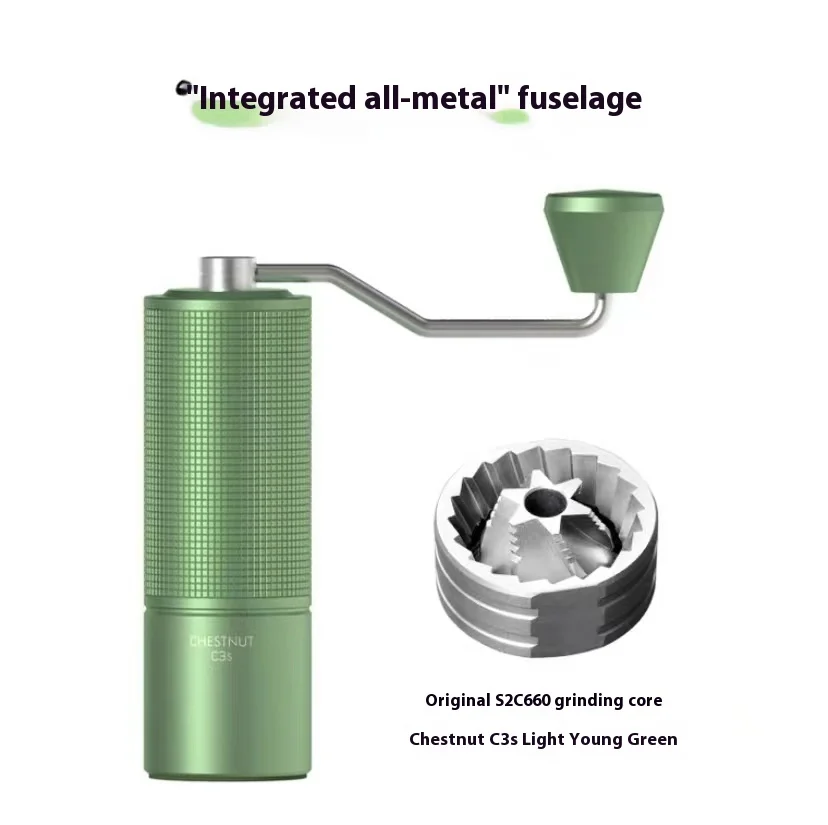
Frequently Asked Questions About Burr Materials
Do ceramic burrs last longer than steel burrs?
Ceramic burrs typically maintain their grinding edges longer than steel, potentially lasting 2-3 times longer before showing significant wear. However, this advantage assumes no accidental damage. A single chip from encountering a stone can compromise ceramic burrs, while steel burrs would likely sustain no damage from the same incident.
Can I switch between burr materials in my existing grinder?
Most grinders are designed specifically for either ceramic or steel burrs. Attempting to interchange them typically causes alignment issues, performance problems, and potential damage. Always use the burr type specified by your grinder’s manufacturer.
Which material is better for light versus dark roasts?
Light roasts often benefit from ceramic burrs’ thermal properties that help preserve delicate floral and fruit notes. Dark roasts generally perform well with either material, though some prefer steel burrs for enhancing body and chocolate notes in darker profiles.
Are ceramic burrs worth the extra cost?
For dedicated espresso enthusiasts, light roast aficionados, and those who prioritize long-term performance stability, ceramic burrs often justify their premium price. For general-purpose brewing, travelers, or those grinding primarily medium to dark roasts, steel burrs typically offer better value.
How do I know when my burrs need replacement?
Signs indicating replacement include noticeably longer grinding times, inconsistent particle sizes, unusual grinding noise, or visible damage to the burr surfaces. Most home users will replace grinders before ceramic burrs wear out naturally, while steel burrs might show performance decline after processing several hundred pounds of coffee.
What about titanium-coated or titanium-nitride burrs?
These specialized coatings applied to steel burrs aim to combine steel’s toughness with improved edge retention and reduced friction. While promising, their performance benefits remain debated, with some premium grinder manufacturers adopting them while others stick with traditional materials. They typically command premium prices and target professional or prosumer markets.
The choice between ceramic and steel burrs ultimately depends on your specific brewing preferences, maintenance habits, and coffee journey. By understanding the distinct characteristics of each material, you can select the grinder that will best serve your pursuit of the perfect cup.

